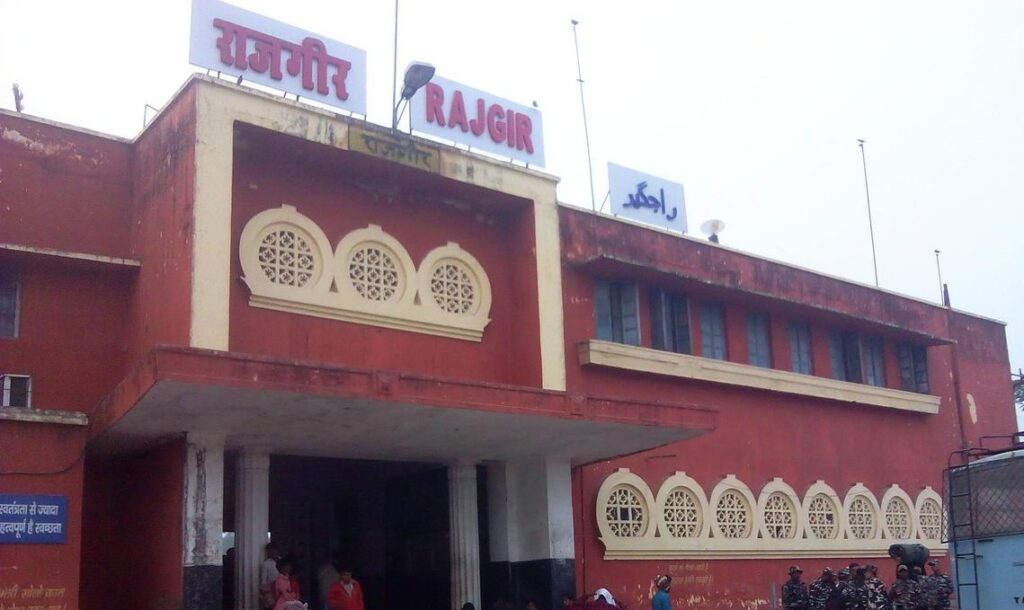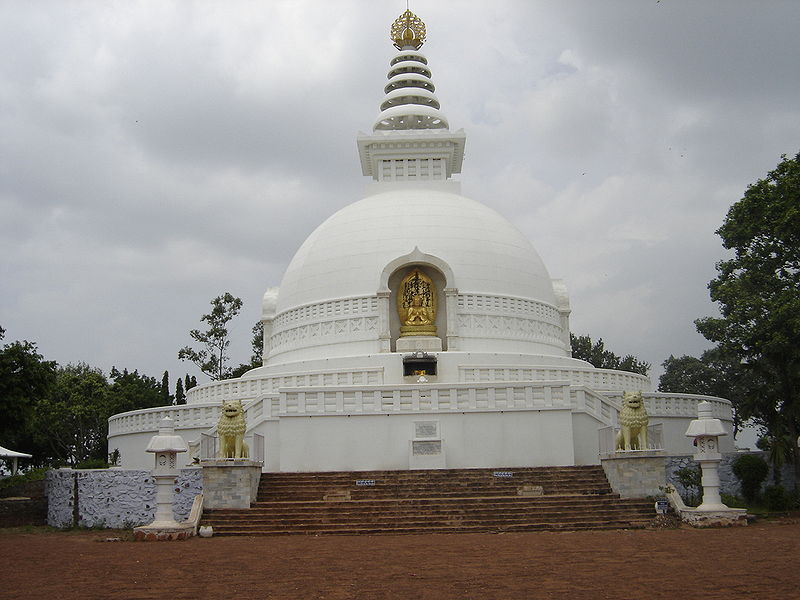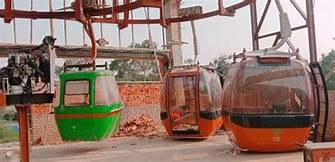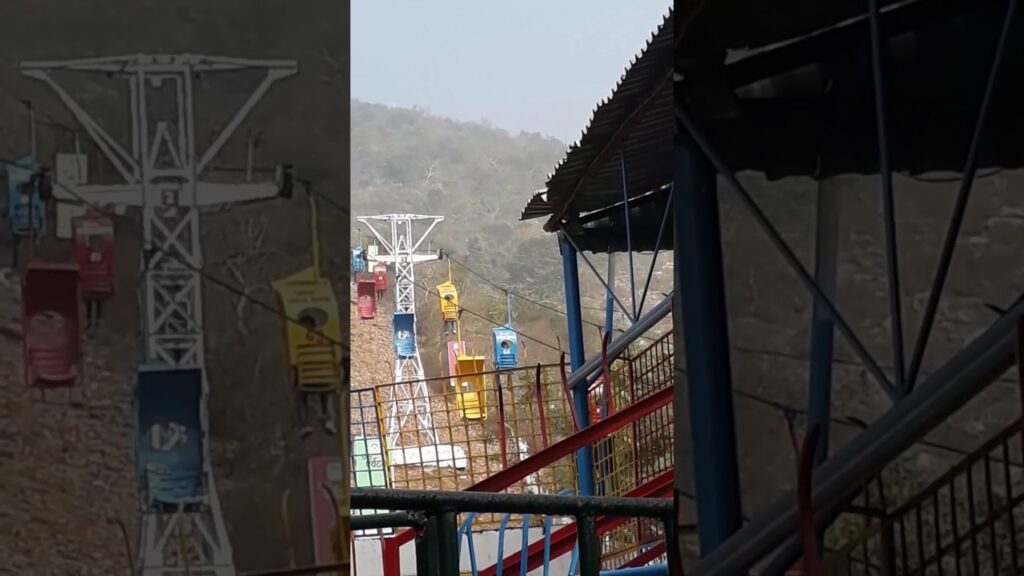Rajgir
Rajgir is an old city in Bihar, a state in northeast India. It is notable for its holy places and is surrounded by hills. The Cyclopean Wall, which ringed the city centuries ago, is still visible in the middle. Venu Vana Park, nearby, originally housed a Buddhist monastery. A massive Buddha statue may be seen inside the shield-shaped Japanese Temple. There are hot springs nearby that are thought to have therapeutic powers.
HOW TO REACH RAJGIR
Rajgir does not have an airport, however, it is accessible by road to Gaya, which has. Rajgir is reachable by train and road. Here’s how to go to Rajgir:
BY AIR
Gaya Airport is located around 68 kilometres southwest of town. It has direct flights to Delhi, Kolkata, and Varanasi. It also has international connections to Kathmandu, Colombo, and Bangkok. Patna airport, located around 98 kilometres northwest of town, is well connected to most Indian towns. Taxis are accessible from both airports to Rajgir.
BY TRAIN
The Rajgir railway station is less than a kilometre from the town centre. Gaya railway station is the primary railhead, located about 60 kilometres southwest of Rajgir, and is connected to major cities around the state as well as other metros around the country.

BY ROAD
Rajgir is connected by private and state-run buses to Patna, Gaya, Nalanda, Pawapuri, Bihar Sharif, and many more places in the surrounding region.
21 Best & Attractive Places To Visit In Rajgir Bihar India
- Naulakha Temple
- Xuan Zang Memorial Hall
- Shilpa Gram
- Kundalpur Jain Temple
- Black Buddha
- Nalanda Archaeological Museum
- Nalanda University
- Pawapuri Jain temple
- Pandu Pokhar
- Vishwa Shanti Stupa / Rajgir Ropeway
- JIVAKA’S Mango Garden
- Rajgir Brahma Kund or Hot Spring
- Sonbhandar Caves
- Manihar Math
- Bimbisara jail
- Rath chakka stain
- Veerayatan
- Japanese Temple
- Venuvan
- Ajatshatru Fort
- Wat Thai Siri
Rajgir is the most visited and well-known destination in Bihar. The entire area is rich in historical significance. It has the world’s oldest university, Nalanda, which is a short distance from Pawapuri, where Mahavira Tirirankara attained Mahaparinirvana. On the other hand, it has the World Peace Pagoda, Venuvana, and other structures. This Nalanda Rajgir tour plan guide will give you a good overview of Rajgir.
1. Naulakha Temple
Naulakha Temple is a popular tourist destination in Rajgir, Bihar. Sri Jain Shwetamber Temple is another name for it. This temple honours Lord Nunisuvrat Swami. The 20th Tirthankara of Jains and Lord Rama’s contemporaries here took place at four fortunate occurrences in his life.
2. Heung Tsang memorial hall at Nalanda
Naulakha Temple is a popular tourist destination in Rajgir, Bihar. Sri Jain Shwetamber Temple is another name for it. This temple honours Lord Nunisuvrat Swami. The 20th Tirthankara of Jains and Lord Rama’s contemporaries here took place at four fortunate occurrences in his life.
Heung Tsang Memorial Hall History
The Memorial Hall serves as a symbol of Indo-Chinese friendship. The hall is named after the famous scholar and monk Xuan. The Memorial Hall represents the Indo-Chinese brotherhood. The hall is named after the famous monk and scholar Xuan Zang, also known as “Bhikkhu Jagdish Kashyap,” the founder and director of Nava Nalanda Mahavihara. He was the one who recommended the creation of this memorial hall. The memorial hall was initially proposed by Bhikkhu Jagdish Kashyap, the Founding Director of Nava Nalanda Mahavihara.
The building of the Xuanzang Memorial Hall began in January 1957 and was finished in 1984. The Memorial Hall was given to the Nava Nalanda Mahavihara for refurbishment, rebuilding, restoration, and artistic growth in 2001. In 2007, it was ultimately dedicated. Nava Nalanda Mahavihara University intends to build Xuanzang Memorial Hall as a centre of orientation for national and international Buddhist pilgrims.
The exhibition “The Pilgrimage Legacy of Xuanzang” depicts the life and legacy of Hiuen Tsang’s voyage to India. During King Harsvardhana’s reign, he came to acquire Buddhist writings from the old Nalanda University. The show uses 18 maps and images to describe Hiuen Tsang’s life.
Hiuen Tsang is often regarded as the father of Buddhist archaeology in India. The excavators had located the most of the Buddhist sites in India; they had learned the most of their information through Hiuen Tsang. He was an excellent tour guide and translator. His travelogue on the voyage from China to India is extremely important.
3. Shilpa Gram Nalanda
Shilpa Gram is located just next to the Hiuen Tsang Memorial Hall. Locals in Shilpa Gram carved Buddha and other deity sculptures in their own distinctive way. There are also several little selling counters where you may purchase the idols at extremely inexpensive prices. This idol may be found all across Bodhgaya and Gaya. This is where the sculptures are mass-produced. Visit the Huen Sung Memorial Hall, the Srijani Shilpa Gram, the Kundalpur Sitambar Jain temple, and the Black Buddha when visiting Nalanda Vishwa Vidyalaya. Those locations were discovered during the excavation of the Nalanda Vishwa Vidyalaya.
4. Kundalpur Jain Temple Nalanda Rajgir
Shree Indrabhuti Gautam Swami was Lord Mahavira’s first disciple. Gautam Swami was born in the hamlet of Gobbar around 607 BC. Kundalpur is the capital of Magadh’s King Shrenika’s realm. He was Prithvi Devi and Vasubhuti’s son. Indrabhuti, a very clever child, became a knowledgeable scholar of 14 various high-quality pieces of information such as Vedas, Vedanta, Puran, Upanishad, and so on in a short period of time.
5. Black Buddha Nalanda
The black Buddha temple is located near the remains of Nalanda University. The temple architecture is straightforward. A large statue of Lord Buddha may be found at the temple. The black basalt rock used to create the Buddha statue. The Buddha idol was discovered during the excavation of Nalanda University. Some sellers sell replicas of the black Buddha in front of the temple gate. The black Buddha temple is located next to Nalanda University, but you must hire a tanga or battery-powered rickshaw to go there because it is in a different direction.
6. Nalanda Archaeological Museum
Nalanda Archaeological Museum was founded in 1971. The majority of the antiques discovered came from the excavation of the ancient site of Nalanda. The museum’s collection includes stone pictures and sculptures, bronzes, terracotta objects, stuccos, iron utensils, ivory and shell artefacts engraved slabs, earthen potteries, and semi-precious stone beads, among other things, dating largely from the fifth to the twelfth centuries A.D.
7. Nalanda University Rajgir Bihar
It was the oldest university in the World. Nalanda to Rajgir distance is 12 km, where ruins of the great ancient university have been excavated. The University of Nalanda was founded in the 5th century AD. Today Nalanda is a famous tourist place in India. Visitors from all over the world rush into it. Though everything is ruined now. But still, this is the most visitable place in Rajgir tour.
8. Pavapuri Jain Temple
Pawapuri is a sinless town located 35 kilometres from Rajgir. It is a major pilgrimage site for Jains. Pavapuri or Pavapuri Jain Temple / Apapuri (city pristine) is one of the sacred sites for Jains. The Jal Mandir (Water Temple) on Kamal Sarovar, also known as Lotus Lake, is exceedingly pious. Mahavira Tirthankara, the greatest founder of the Jain faith, gave his final sermon here and buried Mahaprinirvana. The Swetamber temple is exquisitely designed with white marble. The temple is located in the middle of a lotus-filled lake. Many birds are seen stranded on the lake’s surface.
Burdwan Mahavir, the final Jain Tirthankar and Jainist speaker, is supposed to have gained Nirvana here around 490 BC. Mahavir’s footsteps are in the centre, while his two followers’ imprints are on the left and right. Over Diwali night, Mahavir’s birthday, the cover on the footprints is lifted, and Mahavir appears as a revived presence. Devotees and disciples from all over the world travel to partake in the experience of a holy visit.
9. Pandu Pokhar Rajgir Bihar
Pandu Pokhar is a theme park set in a natural setting. On the second day of my Rajgir tour, I went here. This location’s breathtaking surroundings and exciting activities combine to form PANDU POKHAR. From enticing gardens to an open-air theatre, there’s something for everyone. A 37-foot-tall bronze monument of King Pandu was carved from a pond. A park with a unique combination of entertainment and camping is created. It is approved for business events, school tours, family gatherings, and other social gatherings. Truly a must-see site for the ideal holiday.
10. Rajgir Ropeway
Rajgir, Bihar is the location.
8:00 a.m. – 5:00 p.m.
Enjoy a day in the cradle of nature by taking the Rajgir ropeway in Bihar to the summit of the picturesque Rajgir Hill, which houses the famed Vishwa Shanti Stupa, also known as the World Peace Pagoda.
– Ascend slowly and steadily to a height of nearly 1000 feet above the earth and immerse yourself in the gorgeous vistas. For ages, it has been an important pilgrimage place for Buddhists, Hindus, and Jains alike. There are numerous more religious, historical, and culturally significant sites on the summit.
11. JIVAKA’S Mango Garden
Jivaka, a specialist in traditional medicine and a doctor in India, understood how to heal various maladies with plants and herbs. This garden bears the legend’s name. It’s an excellent area to visit if you’re unfamiliar with the countryside. For us, this is a general visit, but for others, it may be fantastic.
12. Rajgir Brahma Kund or Hot Spring
Rajgir Hot Springs are the sacred natural water springs in Rajgir, Bihar, located 3 kilometres from Rajgir Railway Station. It is one of the most popular hot water springs in Bihar and one of the most important pilgrimage sites in Rajgir. It is located near Pandu Pokhar. Hot Water Springs, located at the foot of Vaibhava Hill, are one of Rajgir’s most famous attractions. In Rajgir, there are around seven Hot Springs that are regarded significant sites for Hinduism, Buddhism, and Jainism. The water flows from the Saptaparni Caves at the top of the hill, which are said to be the source of the seven Saptadhara streams. With a temperature of roughly 45 degrees Celsius, the Brahmakund Spring is considered the most sacred as well as the hottest.
The Hot Springs are also well-known for its therapeutic properties, which aid in the treatment of a variety of skin disorders. The spring water is gathered in an enclosure that is accessed by a stairway. There are also flowing water faucets where one may bathe. There are separate bathing areas for men and women. Non-Hindus are not permitted to visit the spring. Pippala cave, a large stone edifice with grottos on all sides, is reached by a flight of stairs above the Brahma Kund. It has been recognised as the Pippala stone home, which Buddha and subsequently his followers frequented. It is called for the Pipal tree outside the cave’s entrance, which is supposed to have been visited by the Buddha for meditation after his noon meal on occasion. The edifice is widely known as ‘Jarasandh ki Baithak,’ after King Jarasandh, who appears in the Mahabharata book. Visitors may also go to the Lakshmi Narayan Temple, which is located next to the hot spring.
Timings: 6 AM – 6 PM
Entry: Free
13.Sonbhandar Caves
The Son Bhandar caverns, also known as Sonebhandar, are two manmade caverns near Rajgir, Bihar, India. They belonged to the Jain community. The caves are commonly dated to the third or fourth centuries CE, based on a dedicatory inscription found in the biggest cave, which utilises Gupta writing from the fourth century CE, while other scholars have argued the caverns might possibly date back to the Maurya empire from 319 to 180 BCE. The main cave is rectangular with a pointed roof, and the entrance is trapezoidal, similar to the Barabar Caves’ layout (the first artificial caves of India, dated the 3rd century BCE). Nonetheless, the “Mauryan polish” and finish are of far lower grade. Son Bhandar’s stone is also considerably less hard than the granite of the Barabar caves, therefore it did not need the same level of labour and skills.
14.Manihar Math
Maniyar Math is a historic and religious site in Rajgir, Bihar, approximately 4 kilometres from Rajgir Railway Station. It is one of the most prominent destinations to visit in Rajgir and is located on the road to Bimbisara Jail. The ancient location of Maniyar Math, located virtually in the middle of Rajgriha’s old city, may be associated with the name Manimala Chaitya described in Pali Texts or the temple of Mani – Naga recorded in Mahabharata. The major draw here is a well-like structure with a 1.2m thick wall and a 3m diameter.
The facade has 0.6 m high stucco representations of a linga adorned with garland, four-armed Vishnu, Nagi, Ganesha wrapped with snakes around his torso, and six-armed dancing Shiva. Unfortunately, most of the pictures from their Gupta era art-style have since vanished. Minor constructions, such as alter platforms and shrines, appear to be built for religious and ritual purposes associated to serpent worship.
Timings: 9 AM – 5 PM
15.Bimbisara jail
According to Buddhist literature, after becoming King, his impatient son and successor Ajatashatru imprisoned his father King Bimbisara here. The prisoner king picked this location for his imprisonment because he could see Lord Buddha ascending up to his mountain refuge atop the Griddhakuta hill from here. The Japanese Pagoda may be seen well. On top of the hill, a stupa of peace was constructed.
16.Rath chakka stain
For about thirty feet, the chariot traces are evident. The rock has been dubbed “mystery rock” because of its two deep parallel grooves. Many people believe that this is the road taken by Lord Krishna’s chariot. The writing on the rock around the chariot sign dates from the first to fifth centuries AD, adding to the enigma.
17.Veerayatan
Veerayatan is available in three sites in Bihar: Rajgir, Pawapuri, and Lachhuar. Detailed information on each of these centres, as well as the different life-changing projects carried out in their specific communities, is provided below.
18.Japanese Temple
The Japanese Temple in Rajgir, Bihar state, India, is a notable tourist destination that attracts a huge number of visitors. People are drawn to Rajgir because it is a picturesque location surrounded by rocky hills. This is a large temple featuring a white statue of Gautama Buddha. It is located in the temple’s main entryway. The temple is surrounded by a gorgeous green landscape that is well-kept. A pillar may also be found within the temple’s main gate. Devotees sit within the temple because it is a quiet and serene environment.
19.Venuvan
The Japanese Temple in Rajgir, Bihar state, India, is a notable tourist destination that attracts a huge number of visitors. People are drawn to Rajgir because it is a picturesque location surrounded by rocky hills. This is a large temple featuring a white statue of Gautama Buddha. It is located in the temple’s main entryway. The temple is surrounded by a gorgeous green landscape that is well-kept. A pillar may also be found within the temple’s main gate. Devotees sit within the temple because it is a quiet and serene environment. There is a big artificial lake with a Buddha sculpture made by Japanese devotees next to it where one may relax and enjoy the tranquil ambiance.
20.Ajatshatru Fort
The Ajatshatru Fort is a historical wonder that stretches back thousands of years. It is thought to have been erected in the time of the Buddha after its namesake, Emperor Ajatshatru. It is a favourite among historians and students of history. It is also an ideal location for photographers to capture a glimpse of well-preserved heritage. The fort is well-known today, despite the fact that it is in ruins and does not appear to be a fort at first look. Ajatshatru is regarded as one of India’s oldest ancient forts. It is, nonetheless, a wonderful spot to visit and a prominent tourist destination in Rajgir. It’s a fantastic spot to visit.
21.Wat Thai Siri
A nice spot to visit. They let us go since we were a Vipassana meditation group. Wat thai nalanda is aTthai Buddhist temple in Bihar. It is located in the nava nalanda mahavihara.
Stay visited chaloghumane.com to know the offbeat travel places in domestic and international destinations.




